Mohenjo-Daro is today a place of cultural and archaeological significance because it contains the remains of an urban city from one of the largest ancient civilizations we have known - the civilization of the Indus Valley. The name is known to mean "the pile of the dead".
The Indus Valley Civilization spans what is now Pakistan, Northeast Afghanistan and parts of western India. Since 1920, around 2,600 sites of civilization in the Indus Valley have been discovered in these regions. It is one of the oldest and largest of ancient civilizations, next to those in Egypt and Mesopotamia. The two most important sites in the Indus Valley Civilization were Mohenjo-Daro and Harappa. Mohenjo-Daro is located in the southernmost province of Sindh in present-day Pakistan. Harappa is located about 400 miles northwest of Mohenjo-Daro, in the province of Punjab.
The Indus Valley Civilization developed gradually, culminating around 2600 BCE. It is said to have a population of around 5 million at that time. It is said that from 2500 to 1900 BC. large-scale floods caused people to move from rural areas to urban cities, and that was when the great development of these cities took place. Urban planning became more complex, a complex water management system (for which the Indus Valley Civilization is also known) was laid out, and a number of other urban cities sprouted. Newer technologies were introduced in metallurgy, for making seals and shell work, and for producing figures. The decline of the Indus Valley Civilization began in 1900 BC, with Mohenjo-Daro being completely abandoned by 1500 BC. The reasons for this decline are still being discussed; however, it is attributed to a possible combination of change during the Indus River, climate change and a disease epidemic in some of the cities.
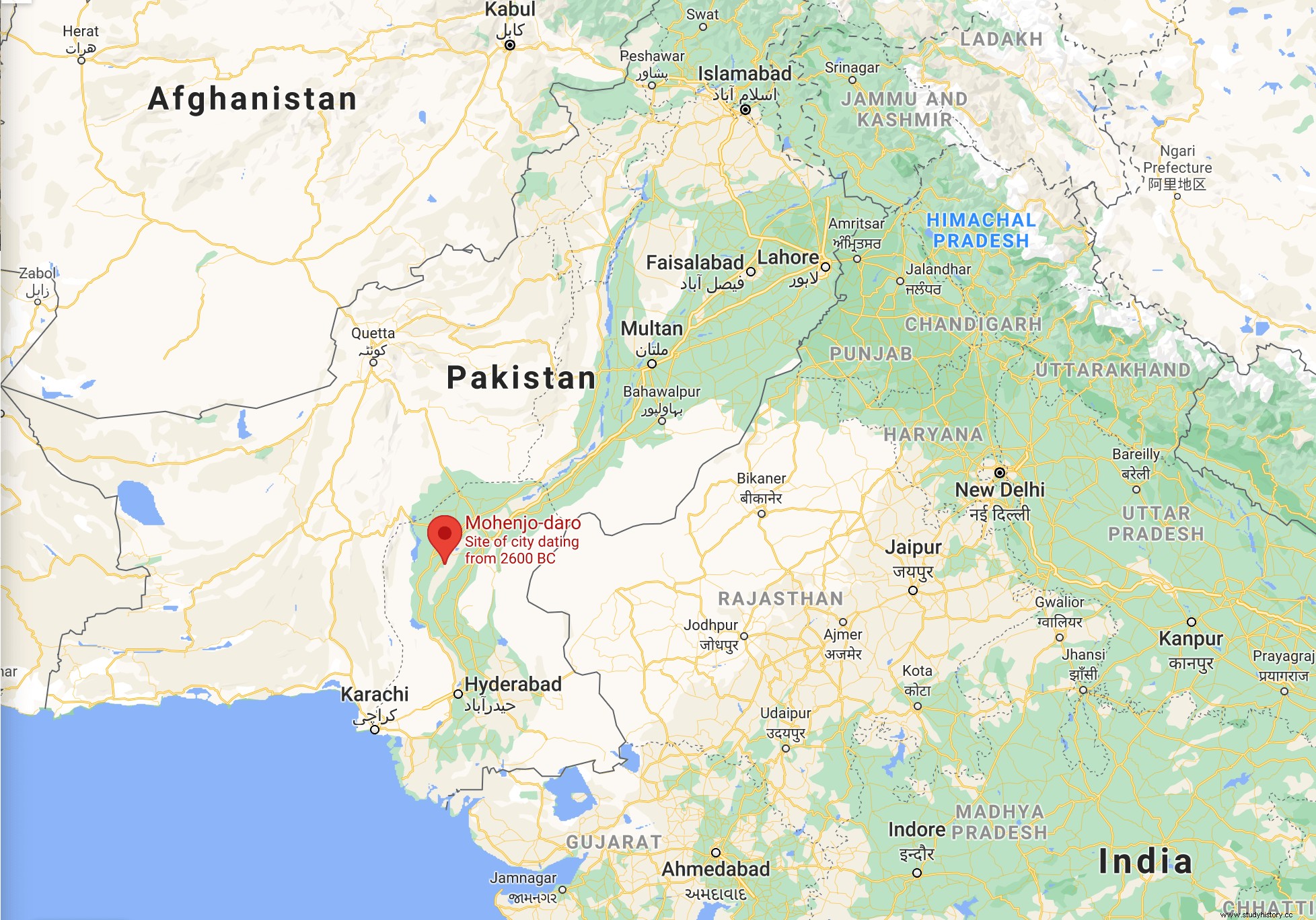
History of excavations and archaeological studies in Mohenjo-Daro
The Indus Valley Civilization was accidentally discovered in the late 19th century, when British engineers John and William Brunton laid the railway tracks from Lahore to Karachi in present-day Pakistan, tripped over the city of Harappa and used the bricks to construct the railway track. Alexander Cunningham, the later director general of the Archaeological Survey of India (ASI), visited the site and identified it as a possible ancient city. He found a seal from Harappa, but rejected that the manuscript was Brahmi.
John Marshall, Director-General of the Archaeological Survey of India (ASI), conducted the first of the proper excavations of Mohenjo-Daro in 1922-23. Between 1944 and 1948, Mortimer Wheeler, Director-General of Archaeological Survey of India (ASI), expanded the excavations at both Harappa and Mohenjo-Daro. These excavations continued after the partition of India and Pakistan in 1947. But eventually they were stopped at many of the Indus Valley sites of civilization.
In 1919, RD Banerji documented Mohenjo-Daro for the first time ever, when he visited it as part of the Archaeological Survey of India (ASI). Over the years, other archaeologists continued the excavation and documentation of Mohenjo-Daro after him; some of them are:Kashinath Narayan Dikshit, Madho Sarup Vats, Herald Hargreaves, DK Dikshitar and Ernest Mackay, and more. In 1965, the excavations of the site were banned due to the worsening erosion of its structures and some land disputes. Since the excavations were banned, a team led by Dr. Michael Jansen and Dr. Maurizio Tosi continued the documentation and surface surveys of the site from 1979 to 1985. Mohenjo-Daro was named a UNESCO World Heritage Site in 1980.
Based on these studies and documentation, the excavated site is divided into 6 main areas:the Citadel area, DK-A, B and C area, DK-G area, HR area, SD area and VS area. The citadel area forms the part of the site known as the "Citadel" or "Upper City", while the remaining five areas mentioned exist to form what is known as the "Lower City".
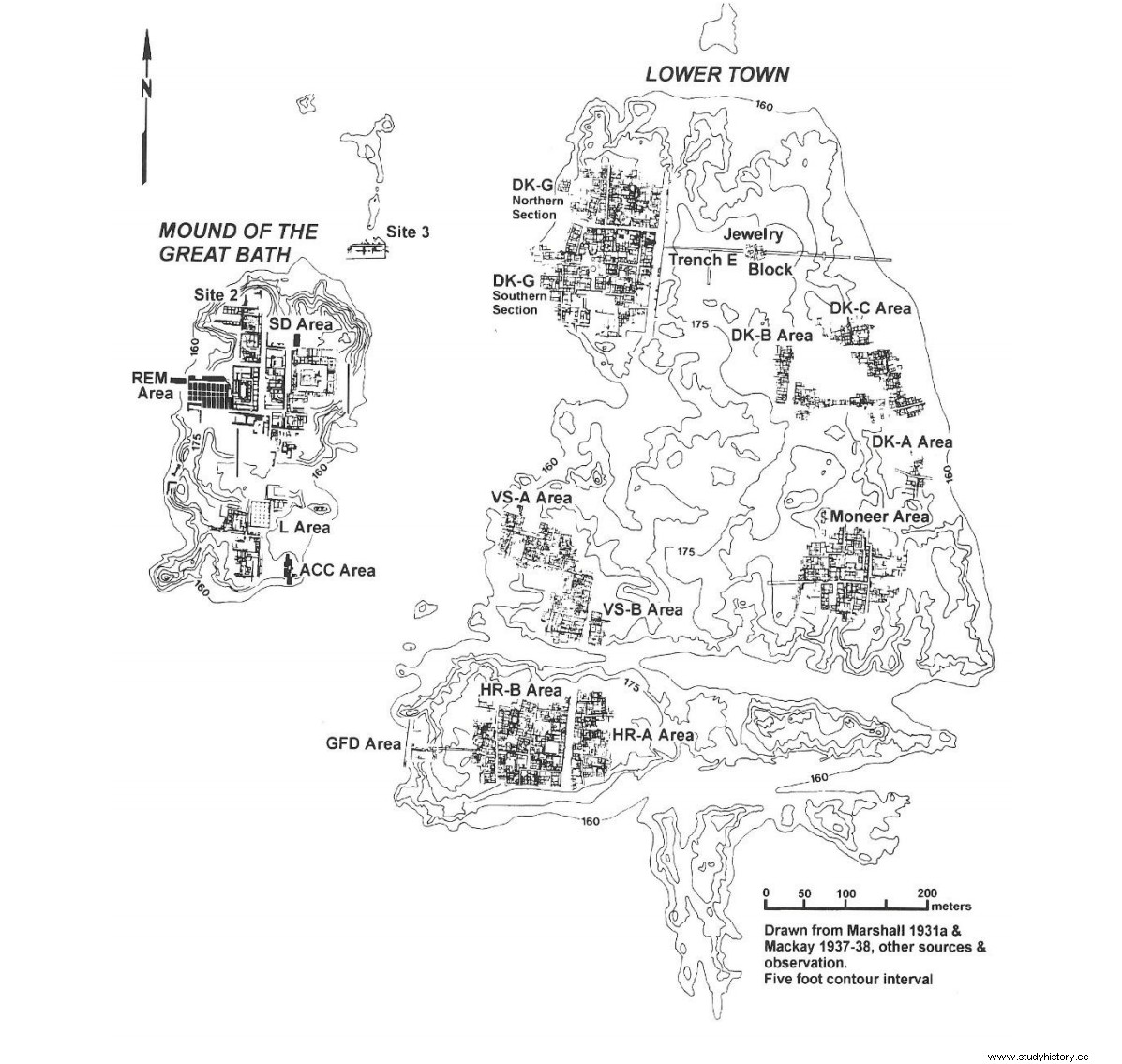
For the traveler, however, the place is introduced as divided into two main areas:'Lower City' and 'Upper City', also known as 'Citadel'.
The layout and architecture of Mohenjo-Daro
Mohenjo-Daro is laid out on a grid plan and covers around 300 hectares of an area. It is divided into rectilinear sections, each measuring 1,260 feet x 750 feet. Each section is further divided by lanes. The city, like Harappa, was not fortified, and the similar designs of these two cities in the Indus Valley suggest that civilization had an administrative and political center of some kind. Mohenjo-Daro had two main areas:the lower city and the citadel. The citadel is a 39-foot-tall clay-brick mound that includes a residential area that houses around 5,000 people, public baths and two assembly halls.
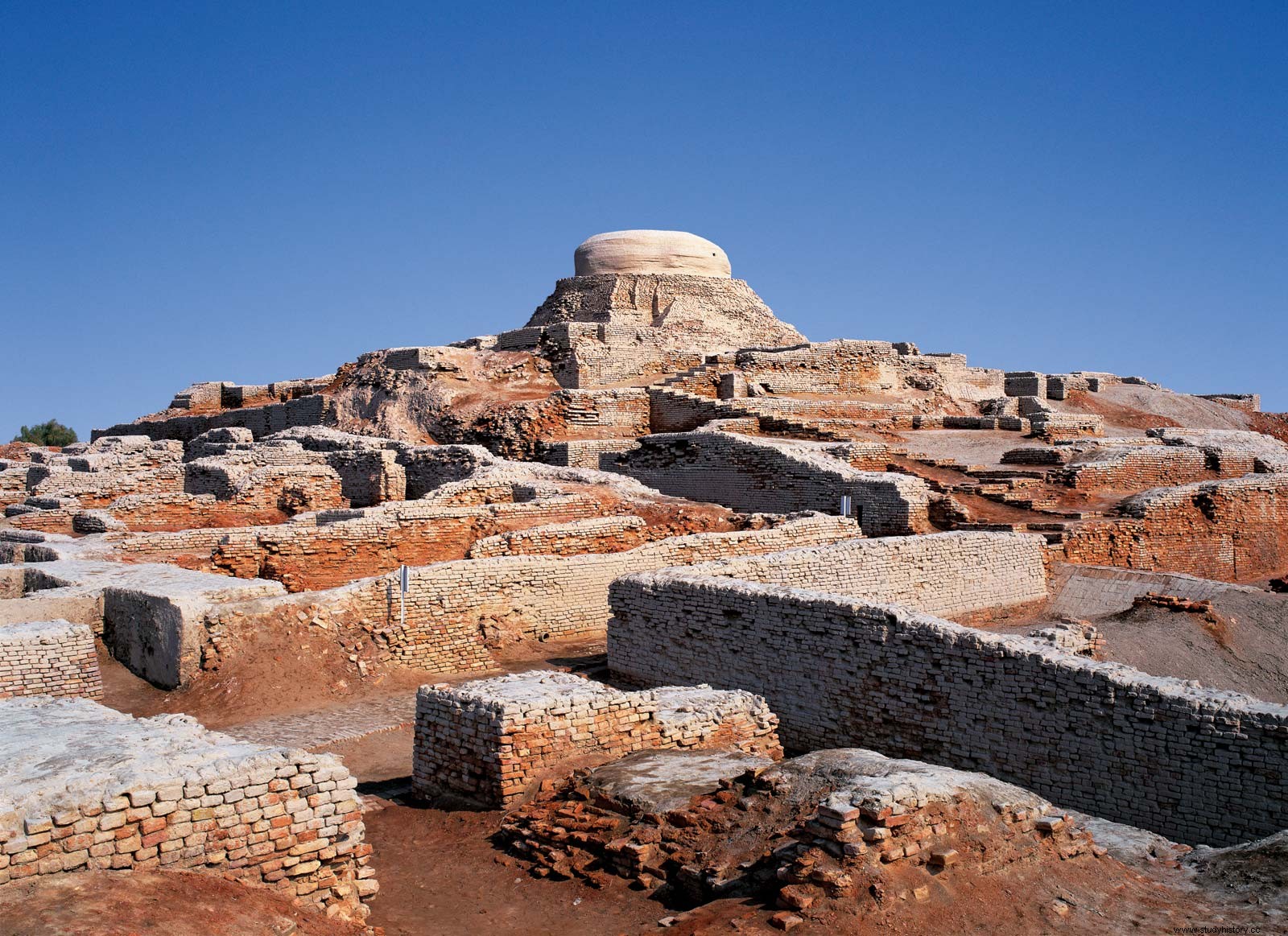
The houses
Most of the built structures were made with fired bricks bricked together. Some houses had two floors, marked with stairs leading up to the top floor. The upper floor could also have been a flat open roof. Most of these houses had central courtyards that would open onto the street. The more prestigious inhabitants had two rooms in their houses, one of which was apparently used for bathing. A building has an underground stove that was probably used to heat the house or to heat the bathing area.
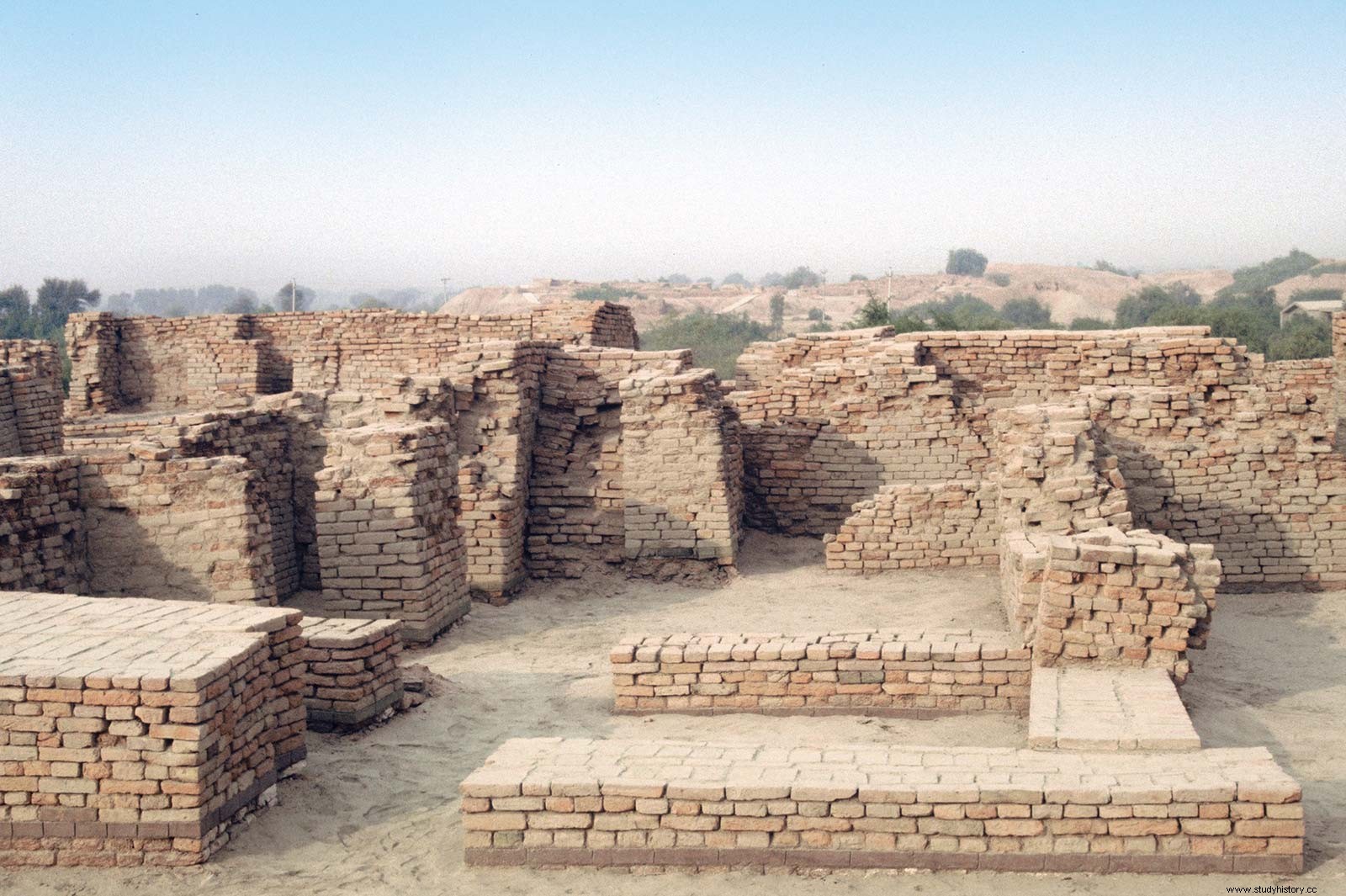
A central marketplace housed a large central well. Residents would get water from smaller wells in the city, as individual households to a well or as groups of households to a well. Mohenjo-Daro is known for its sanitary system, one of the first of its kind in the world.
Wells, water supply and sanitation in Mohenjo-Daro
Mohenjo-Daro has around 700 wells, in addition to baths and drainage systems. The large number of wells present suggests that the water sources the city relied on were annual rainfall, in addition to the Indus River flowing close by. The wells were designed to have circular walls not seen in Egyptian or Mesopotamian civilizations of the time, and therefore suggested that these well designs were a special invention in the Indus Valley. The sewage from the individual households would flow into covered drains along the sides of the main streets of the city to be carried away and away.
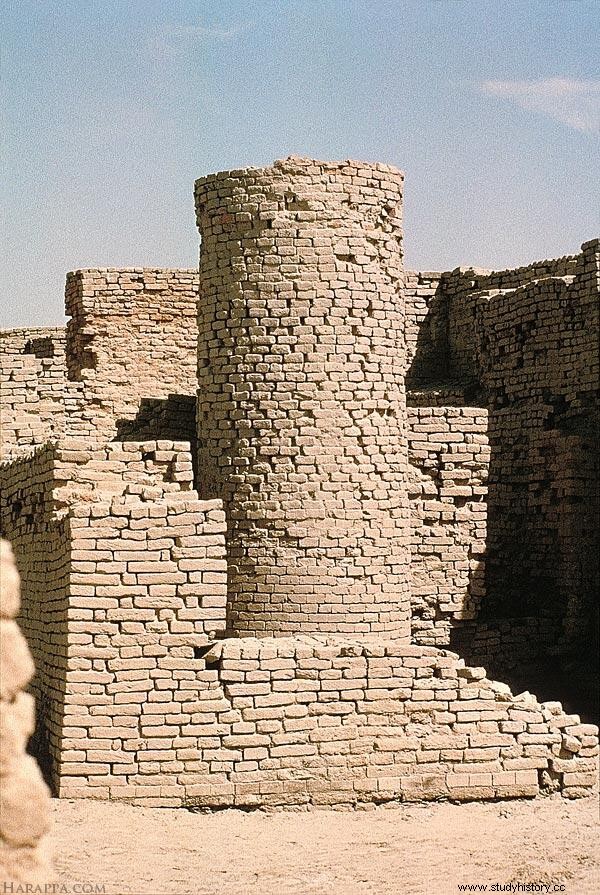
The "great grain factory" in Mohenjo-Daro
In 1950, archaeologist Mortimer Wheeler discovered a structure he believed to be a granary, thus calling it "the great granary". He believed that the partitions in the wooden superstructure meant grain storage with air ducts that dried the grain. According to him. the grain must have been brought in from the land side to the city. However, archaeologist Jonathan Kenoyer pointed out that there was no evidence of any grain in the "grain chamber", and this structure could rather have been a "large hall".
The big bathroom
The Great Bath was a large public bath, made of brick and lined with bitumen to make it waterproof. It measures 12 meters (39 feet) by 7 meters (23 feet) and is 2.4 (7.9 feet) meters deep. It is located near the structure that was previously believed to have been the "Great Granary". The bathroom has steps leading down from a pillar courtyard into it. It is believed to have been used for religious purification rituals.
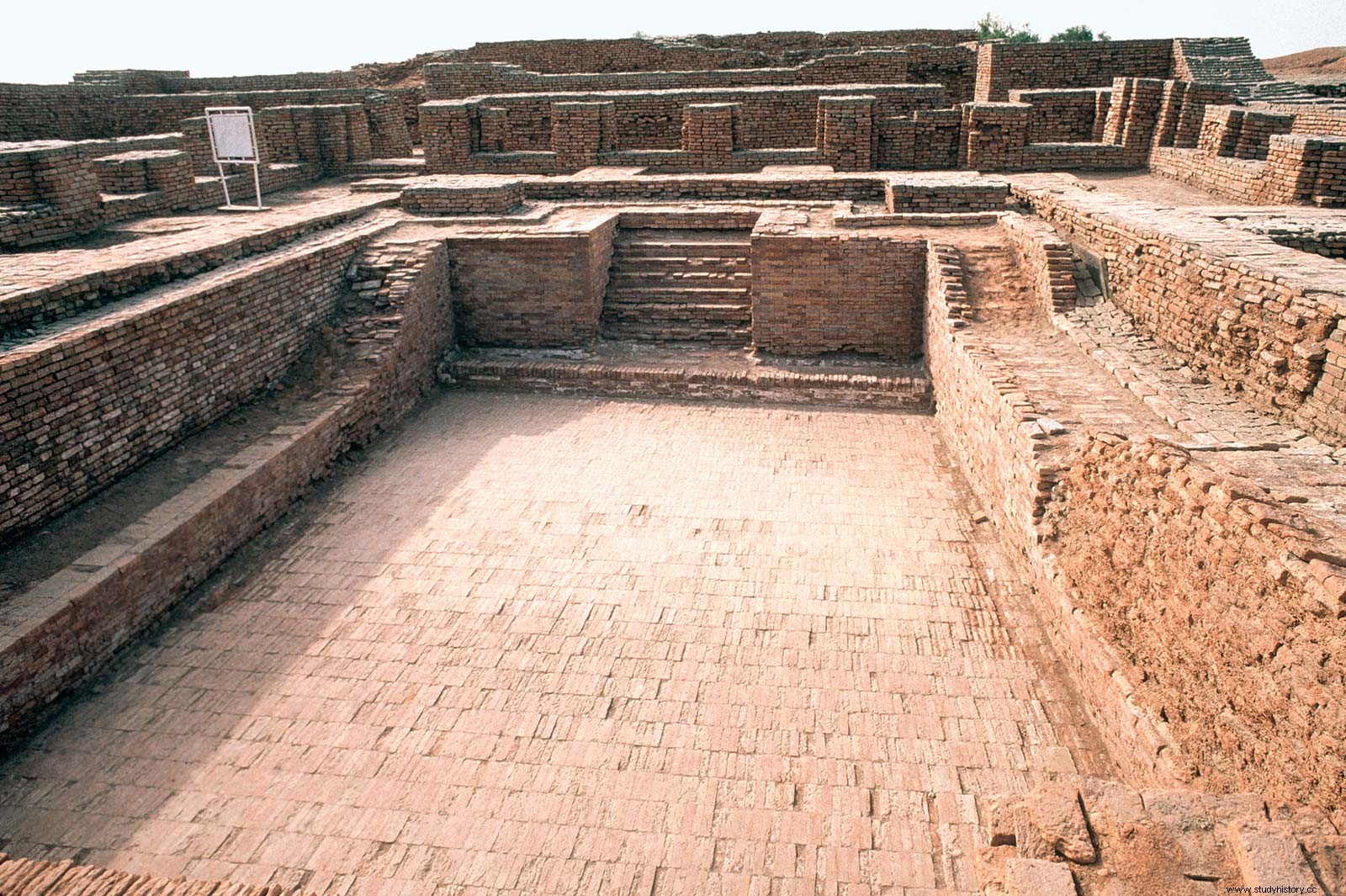
Artifacts in Mohenjo-Daro
The people of Mohenjo-Daro developed techniques in metallurgy (copper and bronze work), ceramic style, harness making, ornamentation and shell work. Some of their most famous items include the priest king, the dancing girl, the mother goddess and the Pashupati seal. With the partition of India and Pakistan in 1947, the objects of the Indus Valley Civilization were divided between the two. From the mentioned objects, the priest king is in Pakistan, while the mother goddess and the dancing girl are in India.
Prestekonge
In 1927, a soapstone figure (steatite) was found by a bearded man. It measures 17.5 centimeters (6.9 inches) in height and 11 cm in width, and shows a bearded man with combed hair. He wears a headband or a ribbon with an inlaid ornament in the middle of the ribbon. He wears a similarly designed but smaller in size bracelet on his right arm. The mantle drapes over the left shoulder, and its design consists of wooden foils and circles that were originally pigmented red. He has holes in his earlobes and is wearing a cloak and a bracelet. The eyes are deeply chiseled and may have been inserted in the beginning. Archaeologists call this figure "the king of priests" despite the fact that there is no evidence that any priests or priests ruled Mohenjo-Daro.
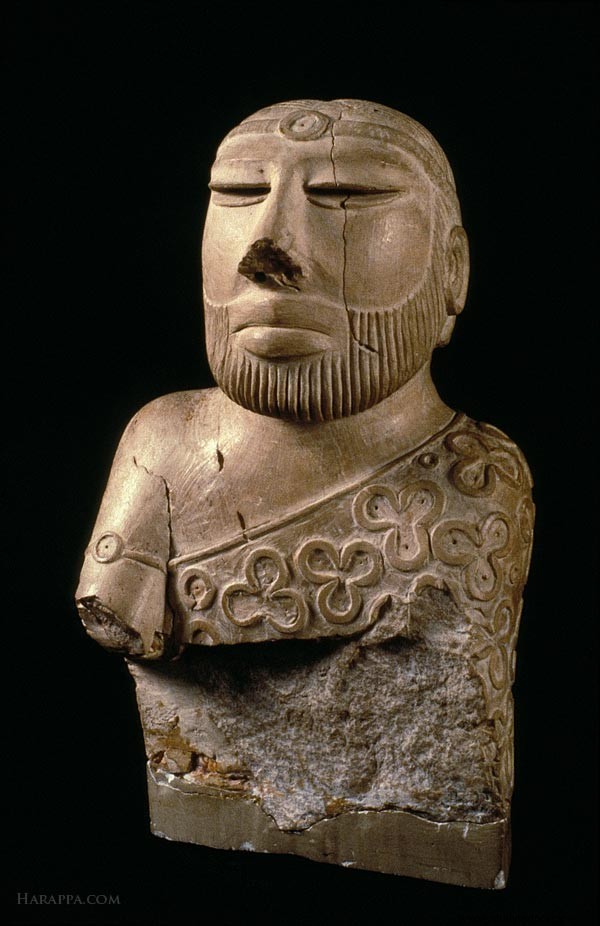
Dancing Girl
In 1926, Dancing Girl - a bronze statue 10.5 centimeters (4.1 inches) in height - was found. The girl is adorned with bracelets all the way up her arm. John Marshall claims that the ornaments at that time may have been made of metal, but most of them were most likely made of shell. The common belief is that the girl this statuette depicts was a dancer. If so, the figure reveals a little more about the culture of the Indus Valley Civilization:it reveals that artistic engagement including dance was a way of life for them.
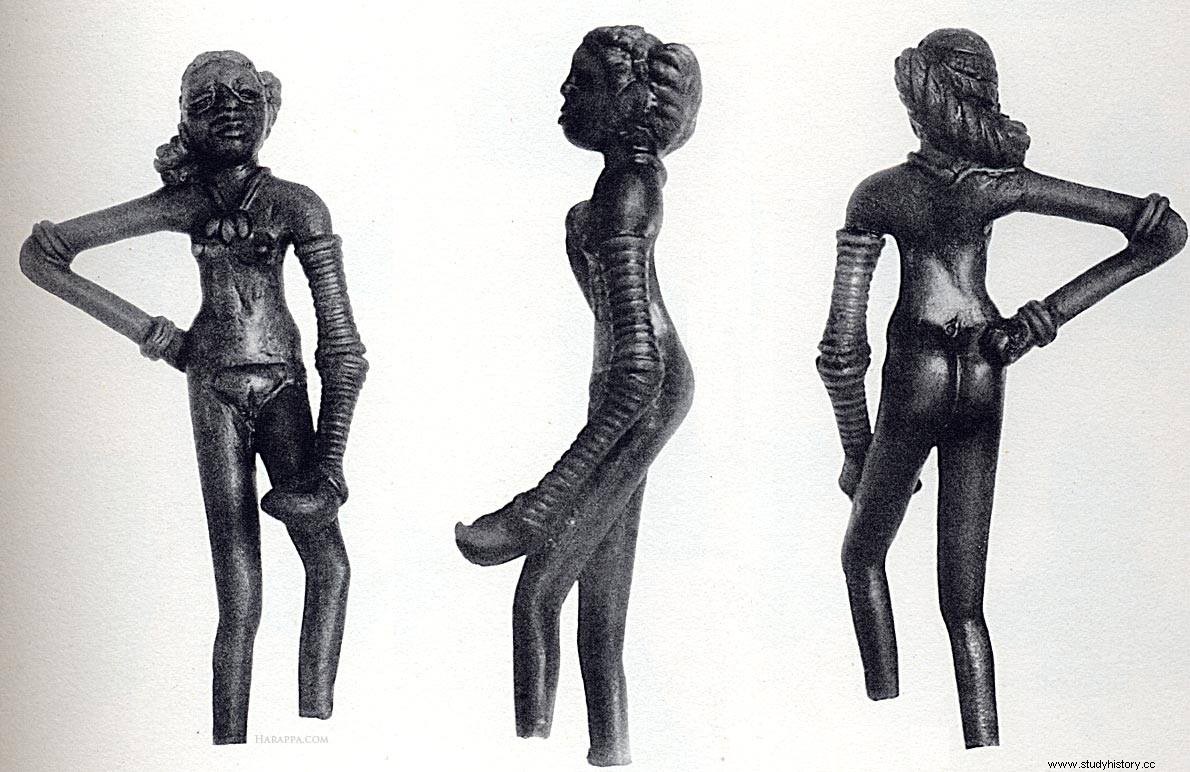
Mother goddess
In 1931, archaeologist John Marshall discovered the figure believed to be the idol of the mother goddesses, not very conceptually different from the mother goddess figures found in the civilizations of the Near East. It measures 18.7 centimeters in height. Many more were found after as well. Marshall suggested that the female genitals are depicted rather exaggerated in these figures, and therefore points to how it must have been a figure that uses the concept of fertility and motherhood. Marshall stated that these figures could be an offer to the morning goddess instead of depicting her resemblance, which would explain why headgear, styles, body conditions and jewelry vary so much on each of these figures.
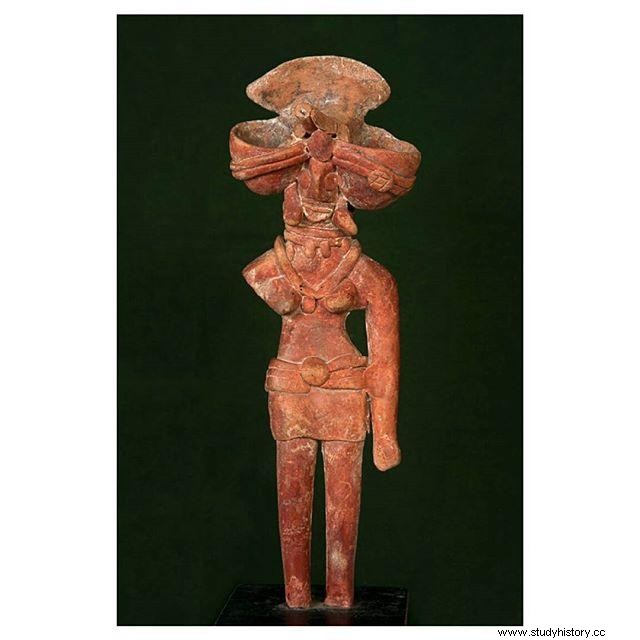
This Mother Goddess theory, also used by Marshall to explain these figures, is an example of a universalist way of thinking that tries to come up with a unique explanation of the seemingly equal over time and space. Archaeologists have talked about evaluating the contextual approach while studying figures instead:realizing that seemingly similar figures found in different regions and different civilizations around the world may just as well have had a very contextually specific philosophy and function around seg. That the figures were not necessarily a representation of or dedication to the mother goddess, and that the concept of a morning goddess in itself may have been a result of the specific cultural philosophies of the earlier archaeologists who studied these material objects.
Seals
Archaeologists have so far found many seals from Mohenjo-Daro. While some have a script, others are only outlined by animal figures etched on them. Among the animal figures that can be seen on the seals, the three most important are:the bull, the antelope and the unicorn. The apple tree (the sacred fig tree) and what archaeologists believe to be deities, also have on these seals.
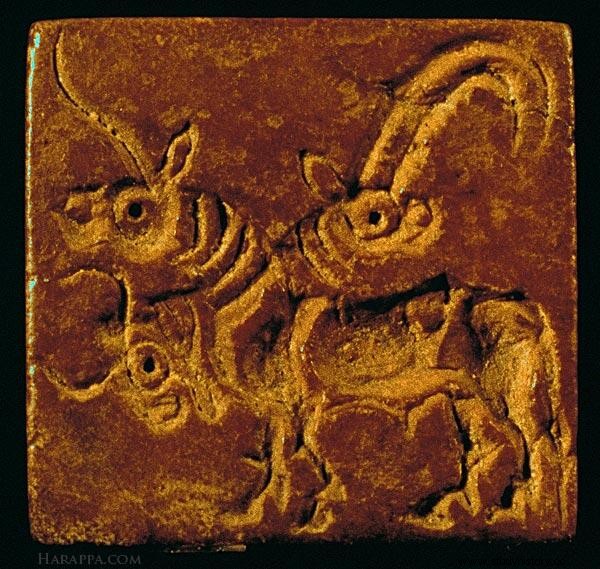
Pashupati sel
The Pashupati seals show a seated figure, wearing a horned headdress, and sitting in a lotus position. This figure is surrounded by animals. Some believe that the figure is a yogi, while others believe it depicts Lord Shiva - the lord of the beasts. The seal is named Pashupati after an epithet of Shiva with the same name "Pashupati".
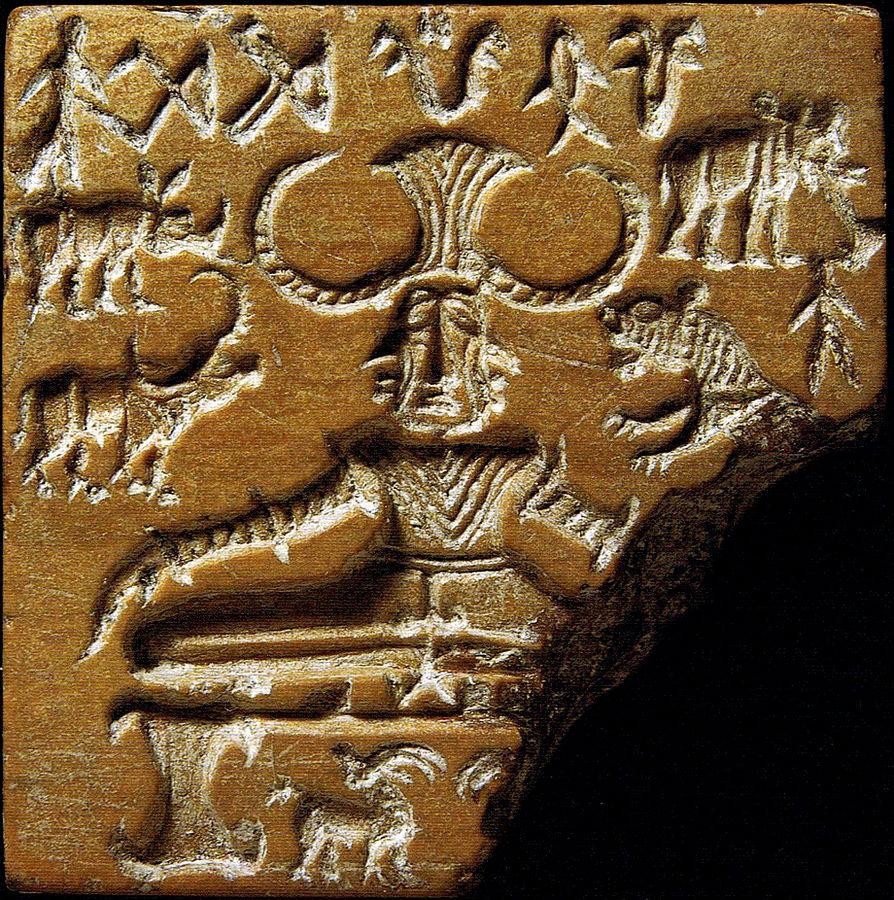
Cultural significance of the Mohenjo-Daro site
Mohenjo-Daro, one of the most important sites in the Indus Valley Civilization, tells us a lot about the people and techniques they developed, worked and reworked in terms of urban planning, water and sewer systems, metallurgy, faience, seal production, ceramics and jewelry design and shell work. What is also interesting is how the way the artifacts are read and understood by archaeologists and anthropologists - for example the "Mother Goddess" figures and the building structure that was previously understood as "Great Granary" - changes over time, and it also bears a mark of its own time!
